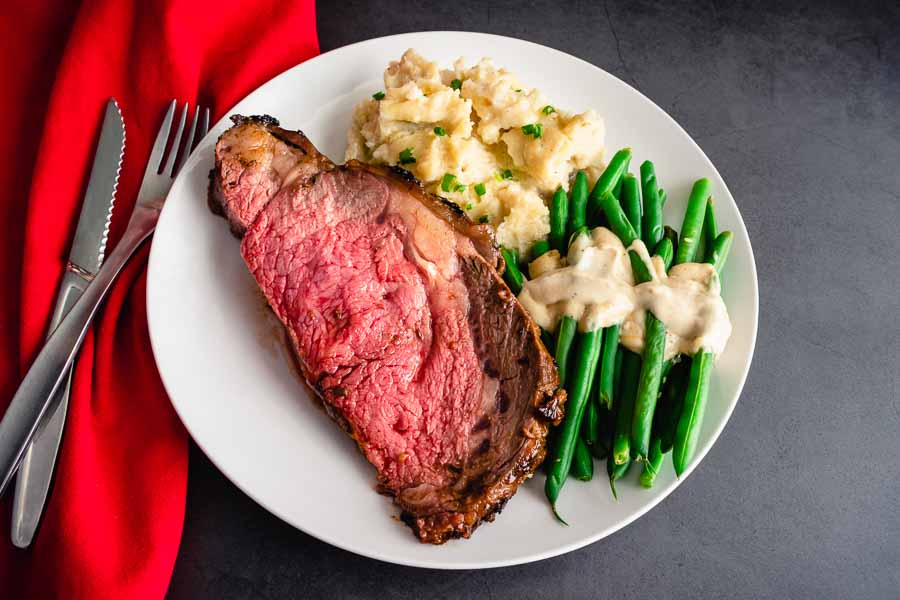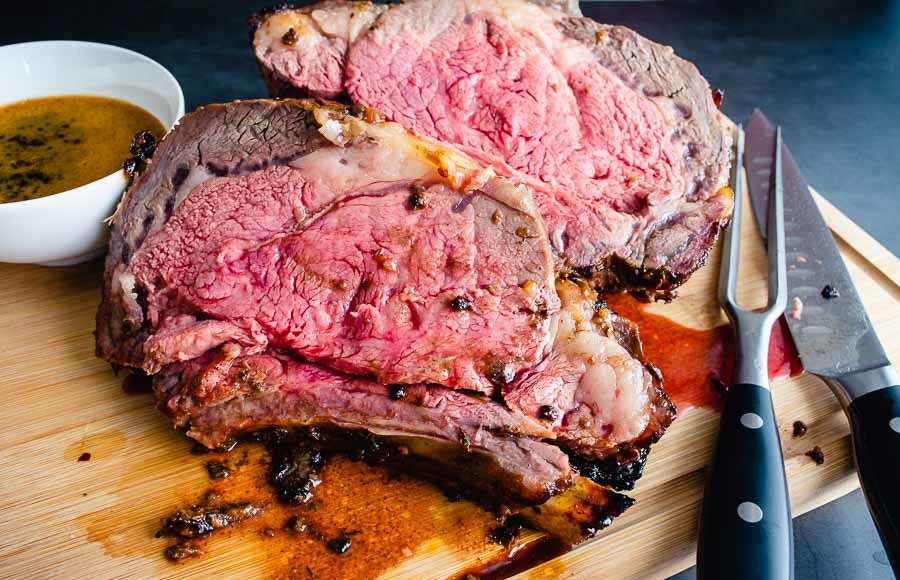What do you normally have for Christmas dinner? Growing up, we always had turkey, stuffing, and all the trimmings. It was the same thing mom served for Thanksgiving, and we loved it. When I started The Hungry Pinner, I decided to change things up and serve ham for Christmas since my husband loves it so much. I’ve done that for the past few years, and I decided it was time to change things up again. After a lot of searching, I ended up choosing this Standing Prime Rib Roast recipe as the centerpiece of my 2021 Christmas menu.
I considered making a roasted goose, but then I discovered that a standing rib roast (A.K.A. prime rib) is also a popular main course. According to this 2020 survey of The Most Popular Christmas Dishes at Taste of Home, it’s far more popular than goose (#55) and even more popular than ham (#11). Prime rib comes in at #6, just below turkey (#3). The top two dishes? Roast potatoes and mashed potatoes, respectively. Gotta love those carbs!
This prime rib roast also called standing rib roast is marinated with a dry rub made with coriander, cumin, paprika. Cooked to a perfect medium-rare, then served with a pomegranate glaze. The perfect roast to serve on special occasions.
The Ingredients
This recipe has a good-sized list of ingredients, and I had to do some shopping. I had honey, olive oil, and brown sugar on hand. I also had all the ground spices and some whole nutmeg that I grated.
That left me to pick up the garlic, thyme, rosemary, pomegranate molasses, and prime rib. The last two gave me a little trouble. I had to try two stores before I found a bone-in beef rib roast. It wasn’t Prime grade, though, and I had to settle for Choice. There’s a little less fat marbling and it’s $5 less per pound, but the butcher assured me the difference isn’t noticeable (he was right). I bought a 4.1-pound roast for $95. It’s the most expensive cut of meat I have ever bought, and I don’t mind telling you I was petrified I would ruin it!
The last item on my shopping list was pomegranate molasses, and I couldn’t find it at any of my usual grocery stores. I ended up ordering a bottle from Amazon for $8. I had to sample it when it arrived, and I can tell you it’s exactly what it sounds like. Thick, syrupy, and sweet with a tangy punch. I loved it!
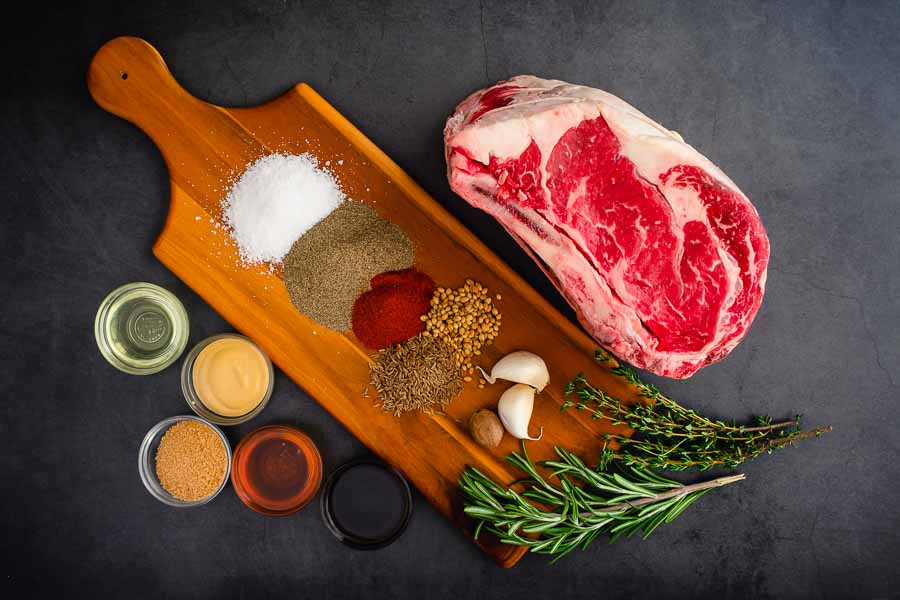
The Process
Making this Standing Prime Rib Roast did take a while, but most of that time was inactive. Waiting for the roast to marinate, warm up, cook, and stand before carving gave me plenty of time to work on the rest of dinner and watch some TV. My active time was about 15 minutes. Here’s how my time was spent:
- 12 minutes to make and apply the rub
- 3 minutes to make the glaze
- 2 minutes to prep
- 1 hour 29 minutes to cook
- 15 minutes to stand
- 2 hours 1 minute total
Dry Rub
Slightly over the 1 hour 45 minute total listed, but not by much. I should note that the above does not include time for the roast to marinate overnight (optional, but I did it) or 3 hours to come to room temperature before cooking.
My Standing Prime Rib Roast started out with making and applying the dry rub. It’s not in the recipe, but the post gives the option of applying the rub and allowing it to marinate overnight. I decided to do that since it barely any extra work and would impart extra flavor.
The dry rub was incredibly simple. Lightly toast the coriander seeds, then mix them in with everything else and crush with a mortar and pestle or food processor. I opted for my mortar and pestle since I find it easier to control. It does take longer, though, so keep that in mind.
Once the spices were blended, I mixed in the olive oil, dried the rib roast, and applied the rub. Then I re-wrapped it and let it sit in the refrigerator overnight.
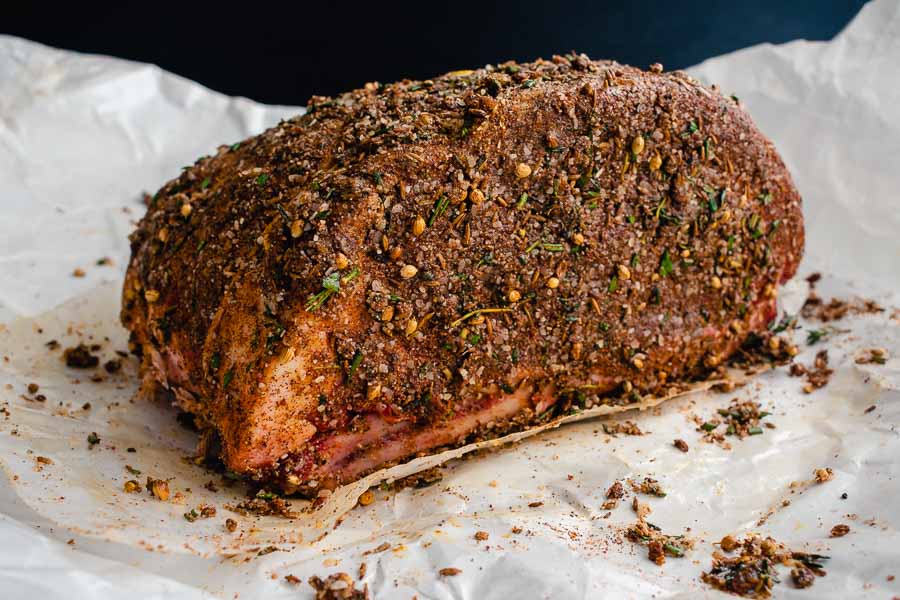
Pomegranate Glaze
The next day I was a bundle of nerves! It was time to cook the roast, but I had a few things to do first. I began by taking the roast out of the refrigerator a good two hours before I planned to cook it. The instructions emphasize this for even cooking.
I mixed up the pomegranate glaze at the same time. This was even easier than the dry rub. Just add all the glaze ingredients to a small bowl and mix thoroughly. Then set aside until it’s needed.
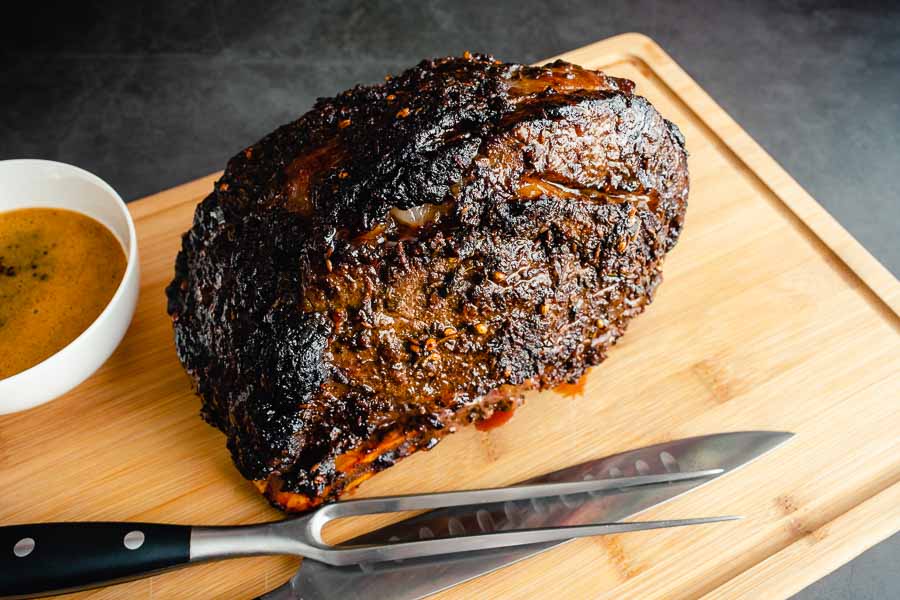
Roasting
I loved the author’s technique for roasting. Using high heat to start off ensures the outside sears, sealing in the juices. I really appreciated not having to sear the roast on the stove first!
I made a small change to the recipe and put the meat thermometer in before putting the roast into the oven. The recipe says to add it after the first 15 minutes, but my way seemed easier. No worrying I would burn myself (I already do that enough!).
I also followed the suggestion of tucking some foil underneath the bones to elevate them. Additionally, I used my roasting pan with a rack.
After 15 minutes, I generously brushed the roast with the pomegranate glaze, turned the heat down, and waited for my meat thermometer to beep. I also set my phone’s timer because I’m paranoid. Hello, $100 roast on the line!
I followed the suggestion in the notes to cook the roast until it reached 120℉ because I had to spend some time taking photos. Despite taking it out of the refrigerator to warm up for a few hours, my roast took an extra 29 minutes to reach 120℉.
The recipe’s blog post gives the option to baste more than once, and I did baste a second time. I figured I might as well while I was checking for doneness after an hour. I was left with plenty of glaze, though.
Once the roast was done, I tented it with foil and used a large nonstick skillet to reduce the remaining glaze. Unfortunately, there were no pan juices to thin it. Instead, I had a big burned-on mess because I forgot to line my roasting pan with foil. Doh! Otherwise, things went pretty smoothly, and I ended up with a beautiful medium-rare roast!
